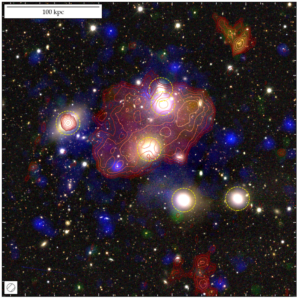Project area/S
- Extragalactic Radio Science
Project Details
Galaxies in the Universe live in a variety of environments, from isolated solitude to the over-dense and tempestuous environments of galaxy clusters (hundreds or thousands of galaxies). Somewhere in between these two extremes we find the most common structures in which galaxies live: groups (tens of galaxies). These structures represent an excellent opportunity to study a rich array of processes including galaxy interactions, active galactic nuclei (AGN) feeding and feedback, and triggering and quenching star formation, and small scale shockwaves. Even though they are the most common type of environment, they have, at radio wavelengths at least, been some of the least studied. With new radio surveys like EMU and POSSUM with the ASKAP radio telescope, we are getting the most detailed look at galaxy groups across the whole southern sky and finding that they host a variety of diffuse radio structures, radio light not associated with any galaxy. These groups with interesting radio emission need to be identified and studied in detail to tell us more about the history and dynamics of the groups as well as the physics producing such emission.
Student Attributes
Academic Background
Preferably astronomy/physics background
Computing Skills
Experience with Unix or linux, python
Training Requirement
Project Timeline
- Week 1 Inductions and project introduction
- Week 2 Background reading and Initial Presentation
- Week 3 Introduction to and acquisition of EMU images
- Week 4 Compilation of galaxy group catalogues and cross match with radio images
- Week 5 Identify any groups with diffuse emission for further follow up
- Week 6 Identification of other available data for groups with diffuse emission (possible telescope proposal if no other data available)
- Week 7 Spectral and brightness analysis of diffuse emission
- Week 8 Identify physics (particle acceleration mechanisms) responsible for emission
- Week 9 Final Presentation
- Week 10 Final Report

Optical (background), X-ray (blue), and Radio (red) view of a compact galaxy group. Shown in red is diffuse radio emission not associated with any one galaxy but thought to be caused by a compression shock wave as one galaxy moved through the group